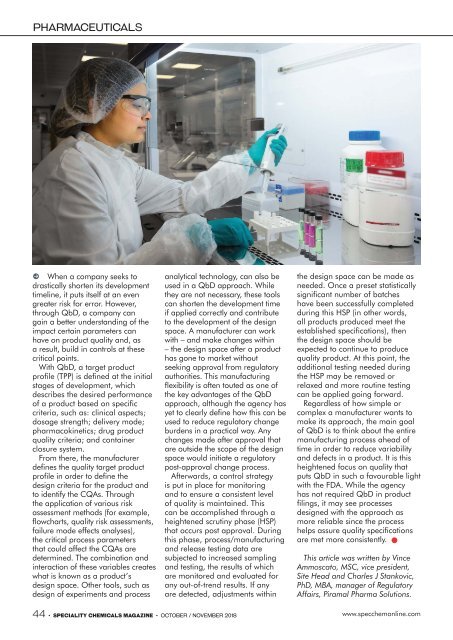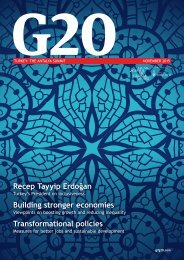Speciality Chemicals Magazine October_November 2018
Speciality Chemicals Magazine is the number one and longest published global magazine dedicated exclusively to the fine and speciality chemicals industries. Our unrivalled reputation for comprehensive coverage and perspective on the global chemical industry makes the magazine essential reading for everyone involved in this market. Speciality Chemicals Magazine has the best established global industry specific print and digital circulation with over 52,000 targeted individuals and distribution to shows and events worldwide. These are personalised subscribers who have requested to be sent a copy of the magazine. This circulation has been built up over 37 years of publishing and has been cleared to European Data Protection Standards (EDPS) 2018. In addition to this personalised circulation, selected articles and industry news are posted on our website, social media sites and in your bi-weekly newsletter.
Speciality Chemicals Magazine is the number one and longest published global magazine dedicated exclusively to the
fine and speciality chemicals industries. Our unrivalled reputation for comprehensive coverage and perspective on the global
chemical industry makes the magazine essential reading for everyone involved in this market.
Speciality Chemicals Magazine has the best established global industry specific print and digital circulation with over
52,000 targeted individuals and distribution to shows and events worldwide. These are personalised subscribers who have requested to be sent a copy of the magazine.
This circulation has been built up over 37 years of publishing and has been cleared to European Data Protection Standards (EDPS) 2018.
In addition to this personalised circulation, selected articles and industry news are posted on our website,
social media sites and in your bi-weekly newsletter.
Create successful ePaper yourself
Turn your PDF publications into a flip-book with our unique Google optimized e-Paper software.
P When a company seeks to<br />
drastically shorten its development<br />
timeline, it puts itself at an even<br />
greater risk for error. However,<br />
through QbD, a company can<br />
gain a better understanding of the<br />
impact certain parameters can<br />
have on product quality and, as<br />
a result, build in controls at these<br />
critical points.<br />
With QbD, a target product<br />
profile (TPP) is defined at the initial<br />
stages of development, which<br />
describes the desired performance<br />
of a product based on specific<br />
criteria, such as: clinical aspects;<br />
dosage strength; delivery mode;<br />
pharmacokinetics; drug product<br />
quality criteria; and container<br />
closure system.<br />
From there, the manufacturer<br />
defines the quality target product<br />
profile in order to define the<br />
design criteria for the product and<br />
to identify the CQAs. Through<br />
the application of various risk<br />
assessment methods (for example,<br />
flowcharts, quality risk assessments,<br />
failure mode effects analyses),<br />
the critical process parameters<br />
that could affect the CQAs are<br />
determined. The combination and<br />
interaction of these variables creates<br />
what is known as a product’s<br />
design space. Other tools, such as<br />
design of experiments and process<br />
analytical technology, can also be<br />
used in a QbD approach. While<br />
they are not necessary, these tools<br />
can shorten the development time<br />
if applied correctly and contribute<br />
to the development of the design<br />
space. A manufacturer can work<br />
with – and make changes within<br />
– the design space after a product<br />
has gone to market without<br />
seeking approval from regulatory<br />
authorities. This manufacturing<br />
flexibility is often touted as one of<br />
the key advantages of the QbD<br />
approach, although the agency has<br />
yet to clearly define how this can be<br />
used to reduce regulatory change<br />
burdens in a practical way. Any<br />
changes made after approval that<br />
are outside the scope of the design<br />
space would initiate a regulatory<br />
post-approval change process.<br />
Afterwards, a control strategy<br />
is put in place for monitoring<br />
and to ensure a consistent level<br />
of quality is maintained. This<br />
can be accomplished through a<br />
heightened scrutiny phase (HSP)<br />
that occurs post approval. During<br />
this phase, process/manufacturing<br />
and release testing data are<br />
subjected to increased sampling<br />
and testing, the results of which<br />
are monitored and evaluated for<br />
any out-of-trend results. If any<br />
are detected, adjustments within<br />
the design space can be made as<br />
needed. Once a preset statistically<br />
significant number of batches<br />
have been successfully completed<br />
during this HSP (in other words,<br />
all products produced meet the<br />
established specifications), then<br />
the design space should be<br />
expected to continue to produce<br />
quality product. At this point, the<br />
additional testing needed during<br />
the HSP may be removed or<br />
relaxed and more routine testing<br />
can be applied going forward.<br />
Regardless of how simple or<br />
complex a manufacturer wants to<br />
make its approach, the main goal<br />
of QbD is to think about the entire<br />
manufacturing process ahead of<br />
time in order to reduce variability<br />
and defects in a product. It is this<br />
heightened focus on quality that<br />
puts QbD in such a favourable light<br />
with the FDA. While the agency<br />
has not required QbD in product<br />
filings, it may see processes<br />
designed with the approach as<br />
more reliable since the process<br />
helps assure quality specifications<br />
are met more consistently. £<br />
This article was written by Vince<br />
Ammoscato, MSC, vice president,<br />
Site Head and Charles J Stankovic,<br />
PhD, MBA, manager of Regulatory<br />
Affairs, Piramal Pharma Solutions.<br />
<br />
www.specchemonline.com
















